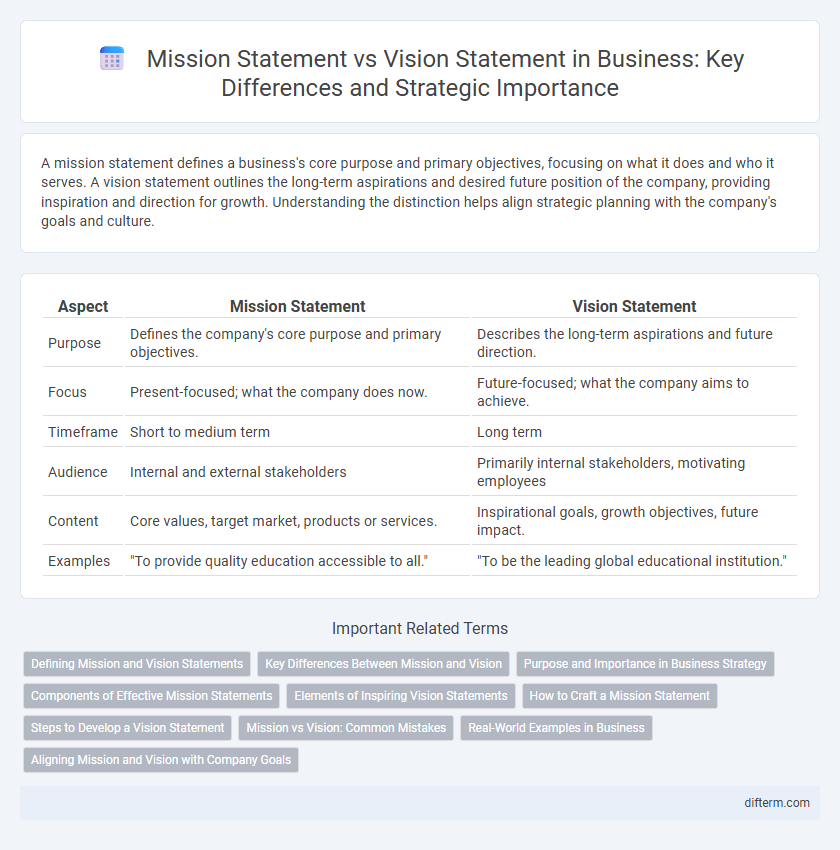A mission statement defines a business's core purpose and primary objectives, focusing on what it does and who it serves. A vision statement outlines the long-term aspirations and desired future position of the company, providing inspiration and direction for growth. Understanding the distinction helps align strategic planning with the company's goals and culture.
Table of Comparison
| Aspect | Mission Statement | Vision Statement |
|---|---|---|
| Purpose | Defines the company's core purpose and primary objectives. | Describes the long-term aspirations and future direction. |
| Focus | Present-focused; what the company does now. | Future-focused; what the company aims to achieve. |
| Timeframe | Short to medium term | Long term |
| Audience | Internal and external stakeholders | Primarily internal stakeholders, motivating employees |
| Content | Core values, target market, products or services. | Inspirational goals, growth objectives, future impact. |
| Examples | "To provide quality education accessible to all." | "To be the leading global educational institution." |
Defining Mission and Vision Statements
Mission statements define a company's core purpose by outlining its primary objectives and the value it delivers to customers, guiding day-to-day operations and decision-making. Vision statements project the long-term aspirations and goals of the organization, offering a strategic direction that inspires and motivates stakeholders. Clear definitions of mission and vision statements enhance organizational focus, alignment, and communication across all business levels.
Key Differences Between Mission and Vision
Mission statements define the core purpose and present objectives of a business, clearly outlining what the organization does and whom it serves. Vision statements focus on future aspirations, describing the long-term goals and desired impact the company aims to achieve. Key differences include time orientation--with mission rooted in the present and vision in the future--and scope, where mission emphasizes operational actions and vision emphasizes strategic direction.
Purpose and Importance in Business Strategy
A mission statement defines a company's core purpose and primary objectives, guiding day-to-day operations and decision-making processes. In contrast, a vision statement outlines the long-term aspirations and the desired future position of the business, inspiring stakeholders and setting strategic direction. Both statements are crucial in business strategy as they provide clarity, align team efforts, and drive organizational growth.
Components of Effective Mission Statements
Effective mission statements clearly define a company's purpose, core values, and target audience to guide decision-making and inspire stakeholders. Essential components include a concise expression of what the business does, whom it serves, and the unique value it delivers. These elements ensure alignment with strategic goals and foster a strong organizational identity.
Elements of Inspiring Vision Statements
Inspiring vision statements emphasize clarity, future orientation, and ambitious goals that resonate emotionally with stakeholders. Key elements include a vivid depiction of the desired future state, alignment with core values, and motivation that drives innovation and long-term growth. Companies like Tesla and Google exemplify this by articulating transformative impacts that inspire commitment and continuous progress.
How to Craft a Mission Statement
Crafting a mission statement involves clearly defining the company's core purpose, target audience, and key values to guide decision-making and operational strategies. It should be concise, specific, and measurable, reflecting the organization's unique strengths and commitments. Effective mission statements emphasize actionable goals that resonate with employees, customers, and stakeholders to drive alignment and motivation.
Steps to Develop a Vision Statement
Crafting a vision statement begins with identifying the long-term goals that define the organization's future success. Engage key stakeholders to ensure alignment on core values and aspirations, forming a clear and inspiring direction. Refine and articulate this vision into a concise statement that motivates and guides decision-making across all levels of the business.
Mission vs Vision: Common Mistakes
Confusing mission statements with vision statements often leads to unclear business direction and diluted strategic goals. Mission statements should concentrate on the company's present purpose and core values, while vision statements must outline long-term aspirations and future impact. Frequent errors include mixing these elements, resulting in statements that neither inspire employees nor guide decision-making effectively.
Real-World Examples in Business
Mission statements define a company's core purpose and operational goals, such as Tesla's focus on accelerating the world's transition to sustainable energy. Vision statements convey a future aspiration, exemplified by Microsoft's aim to empower every person and organization on the planet. Comparing these statements in companies like Nike reveals the mission's emphasis on inspiration and innovation, while the vision projects a world where everyone is an athlete.
Aligning Mission and Vision with Company Goals
Aligning a company's mission and vision statements with its core business goals ensures strategic coherence and drives unified progress. A mission statement defines the organization's purpose and immediate objectives, while the vision statement outlines long-term aspirations, providing a clear direction for growth. Integrating both into goal-setting processes enhances employee alignment, operational efficiency, and stakeholder confidence, ultimately supporting sustainable business success.
mission statement vs vision statement Infographic

 difterm.com
difterm.com